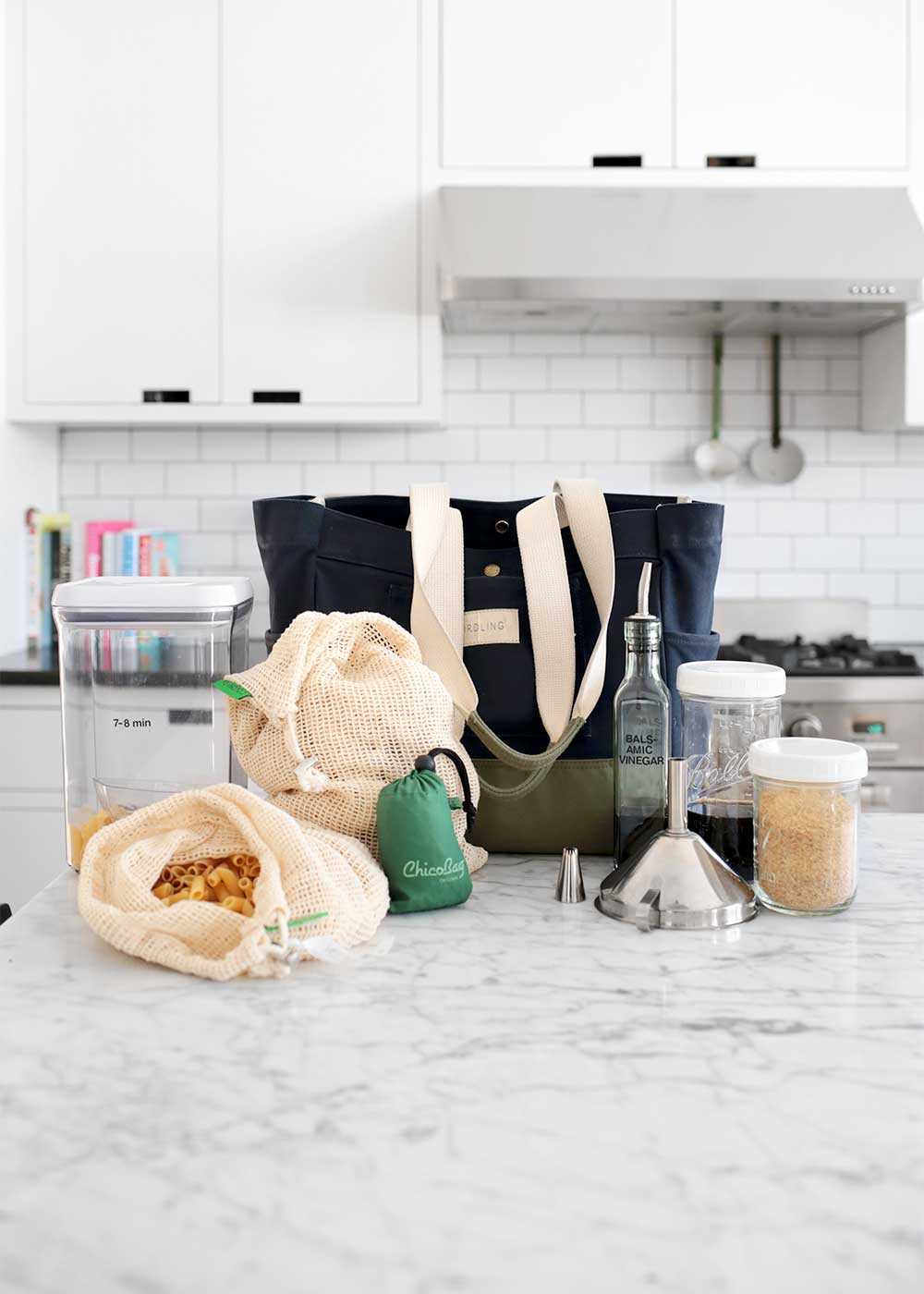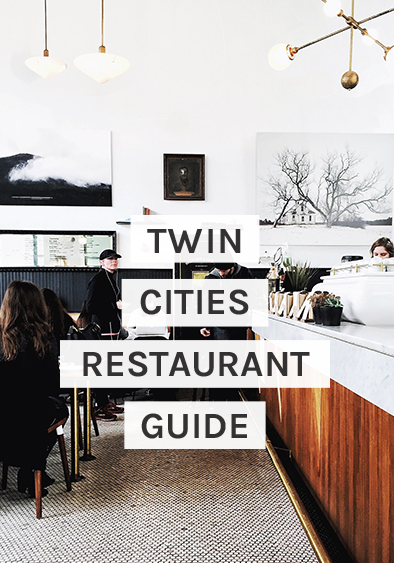
Last week, we took a deep dive into how to shop in bulk. This week, I’m adding in the personal layer of how I shop in bulk, sharing my bulk shopping kit and rhythms. It’s really easy to get excited and start something new, like shopping in bulk. But it’s hard to keep that new thing up without creating long-term rhythms and finding trustworthy tools. User experience is just as important in the bulk aisle as it is when designing a website. And, if your experience is poor, you’ll slowly stop shopping that way. It’s to be expected. Here’s how I’ve made shopping in bulk work. Don’t miss the printable cheat sheet to boost your (my) confidence down the bulk aisle.
Bulk Shopping Kit
I didn’t go out and compile a bulk shopping kit when I started shopping this way. In fact, I didn’t realize I more or less had a kit until meeting with The Wedge Co-op a couple weeks ago, where they recommended compiling a kit to make bulk shopping more doable. I looked down at my sturdy purse that doubles as my shopping bag, filled with reusable produce bags, extra shopping bags wadded up, and a couple Ball jars. I had a kit on my hands, more like, on my shoulder. Here’s what I use.

Purse/Shopping Bag
Grocery shopping is so much a part of my weekly life, I’ve started using a purse that doubles as a sturdy grocery bag. I’ll never go back. My bag is made by Birdling Bags, but they no longer make this specific bag. However, I went in search of something similar and found this nearly identical bag from L.L.Bean. The medium is the same size as mine. It has a pocket inside for everyday purse storage; it’s made from a water-resistant waxed canvas; and it boasts a reinforced, sturdy, wide base for heavy loads (like grocery shopping). If you want to keep your purse sacred, then find a good tote (one with a sturdy base), and store all your bulk shopping tools inside, so it’s at the ready.
I use my purse specifically to house heavy items, like yogurt, glass jars, or other things I want to keep upright when shopping.
Collapsable Shopping Bags
I have 2 Chico Bags that work amazingly well, though I’m smitten with the patterns of Baggu Bags. Both bags collapse into tiny compartments for minimal storage. I keep these in my purse at all times. I typically don’t buy more than a purse and two bags full worth of groceries at a time. Of course, keep as many collapsable shopping bags needed to fulfill your grocery load.
Bulk Bags
I use these reusable bulk bags for both dry goods and produce and keep them in my purse at all times. With the tiny holes though, you’re limited to containing certain ingredients, like nuts and pasta and not flour. I recommend purchasing the same size/weight of bags with the tare weight clearly listed on a tag for shopping and checkout ease. (Keeping multiple bag sizes means you have to dig through your bags to match your ingredient size. It’s entirely inefficient. I made this mistake a couple years ago with a different style of bag, and stopped using the bags altogether due to poor user experience. Side note: I made good use of those bags to corral Hallie’s toys. They didn’t go to waste.)
Many recommend cotton bags for shopping granule ingredients in bulk, like sugars and flour. I haven’t given myself over to these bags yet for a couple reasons. I imagine they’ll require washing after each use. I imagine tiny spills are inevitable out of the top hole. And, I don’t want to carry any more bags in my purse. Even as I’m typing this out, I think I should give one a try before assuming so much. In place of the cotton bags, I prefer jars for now.
Jars
I use widemouth Ball Jars from around the house to purchase granule ingredients (like seeds and spices) and liquids (like vinegar). I can trust them to stand upright in my purse and keep spills and leaks at bay, two very important things to consider when choosing bulk containers. They also have measurements on the side of the jar, making it more intuitive to choose the quantity in bulk. This is great when I’m refilling a spice jar, for example. I know my spice jars hold 3.5 oz, so I can buy the correct amount without overflow. The same is true of my vinegar dispensers.
Tip: Keep one jar specific for bulk shopping and add tick marks with a Vis-A-Vis marker to list common amounts needed to match your containers at home.
Funnel
When shopping in bulk, you inevitably have to transfer purchased ingredients to a permanent container. Keep a trusty funnel on hand, though it’s not necessary to bring to the store as long as you’re using widemouth jars or bags with large openings. I use this one, which is a great multi-purpose funnel. For extra tiny jars, you can use a pastry tip flipped upside down as a tiny funnel. I learned this tip from the pastry queen herself, Zoë Bakes.
Note: If you’re in the Twin Cities, you can find great bulk shopping and reusable containers at brick and mortar stores like The Wedge Co-op, Tare Market (online store too), and The Foundry Home Goods (online store too).
Bulk Shopping Rhythms

Two years ago, I started using my own reusable produce bags. Those bags were my gateway drug into shopping in bulk. However, I didn’t convert to this way of shopping overnight. I started doing little bits at a time as I felt comfortable. In fact, I’m still in the process of converting. I’ve come a long way in reducing our food waste and packaging waste, but I’ve still got a ways to go. Below is a bulleted list of my current rhythm for shopping this way, as well as what I buy.
- I keep my collapsable shopping bags and bulk bags in my purse at all times for everyday shopping. My purse also doubles as a sturdy shopping bag for items that need to stay upright or are particularly heavy.
- When needing special jars to fulfill my grocery list, I plan ahead. With that said, I typically limit my bulk aisle shopping to specific shopping trips so I can gear up literally and mentally. In general, I compartmentalize my shopping trips to help myself out and break up this large task. I typically do longer bulk shopping trips 1-2 times per month and do quick trips to shop for fresh ingredients 1-2 times per week.
- I stock a specific set of ingredients in my kitchen. For example, I buy 1 kind of rice, 2 types of pasta noodles, 20 spices, the same nuts and seeds, etc. I have a clear, permanent container for each ingredient. Bulk shopping works really well for this type of kitchen organization, as I’m able to refill my containers without any additional packaging. If you want to give yourself over to this method, check out my book, The Minimalist Kitchen (currently very low stock) and take The Minimalist Kitchen Course.
- I shop at Costco for extra large quantities of dry goods in bulk like oats, Seven Sunday’s muesli, sugar, milk, butter, chips, eggs, avocados, tequila, and bourbon. Some of their packaging is excessive and some is great. Tip: When shopping in bulk of this quantity, only buy what you can consume before expiration. Otherwise, the price break isn’t worth the food waste.
- I still buy flour in sealed paper bags for easy transportation and low-mess. The paper can be recycled.
- I still buy a specific brand of coconut in a bag that I prefer over the bulk bins.
- I’ve converted to buying these items in bulk: all my spices, pasta, lentils, cornmeal, flaxseeds, half of our nuts and seeds, most of our dried fruit, all of our vinegars, and honey.
- This year I hope to start buying dried black beans and chickpeas in bulk instead of canned, which means I have to give myself over to the rhythm of soaking and cooking beans. I’ve been putting this off for years. Do you have a favorite cooking method for dried beans?
Bulk Shopping Cheat Sheet
I made a little cheat sheet printable for you (and for me) to bring to the store, to feel a little more confident. There are 4 on a page, so cut them out, add one to your bag, and give it to 3 friends.
Download here.

Here’s a quick visual recap of shopping in bulk, from the store to home. To read more in detail about how to shop in bulk, read this post.









Hi! What color paint is your kitchen cabinets?
I’m not actually sure, sorry!
I’m a fan of bulk shopping and have been doing it for a few years. On a recent trip to Whole Foods, I brought and refilled my Mason jar container. At check out, I was told I could no longer bring it in to refill. Something about not being able to verify that it was sanitized. Have you ever run into this issue? I was shocked.
The instant pot method for beans is so fast and easy – and they freeze so well. No soaking required, and they are fantastic! I could never go back to the soak and stovetop method!
I prefer to cook my own beans, and my preferred method is to soak them for 24 hours. I recently learned that one should add significant salt to the soaking beans, as well as a little baking soda. Brining the beans apparently keeps them from bursting while cooking, as well as adding flavor (haven’t tried that yet). The great thing about soaking beans for 24 hours is that they then take only 30-40 minutes to cook. I also soak my lentils, and those take less than 30 minutes to cook.
I moved to Utah from Minneapolis 12 years ago, I miss the Wedge! We are without any co-ops here in Utah, but your post has me inspired to check out the bulk bins at our Whole Foods.
For dry beans, we use an electric pressure cooker (essentially an Instant Pot, but a different brand). It makes dry bean prep so easy!
I have almost the same shopping kit and use the same mason jars with plastic lids. However I’m so waste averse that I don’t use the adhesive labels for the tare/PLU. If I use a little effort, the store pencils write right on the plastic lid. Then I store all of my bulk items right in the jars prettily lines up on my shelf. No need to transfer back home!
I miss The Wedge and Co-op shopping! There are like two or three tiny co-ops in Ireland. I still can’t believe that. These are such great posts Melissa, brilliant suggestions. Hope all is well. xx
Thanks Melissa. This is very helpful.
Zerowastehome.com is also an excellent resource as well.
I use the Dutch oven method from A Couple Cooks for making dried beans. So easy and no soaking required. Have not bought canned in over a year.
I have found the process of cooking dried beans to be easier than I expected. I just get them soaking in the dutch oven before I go to bed, and then in the morning do a quick water change over and turn the burner on for an hour or two while I do breakfast/getting ready. I always do a big batch and freeze them in portions.
This is all so helpful. Thanks, Melissa!
Question: How do you decide when to get more of an ingredient? And, what do you do if your container for it back home isn’t quite empty yet? Do you add new stuff to old? Do you keep the new stuff in limbo till the container is empty?
I’d also be curious about what you do with this for things you don’t buy in bulk (like flour). Where do you keep the new bag of flour until it’s ready to add to your clear container? etc.
Thanks so much!
My instantpot has converted me to dry bean buying. It’s pretty easy and quick to dump it in and they turn out creamy and delicious. I freeze them in quantities for when I want them.
This post right on serious eats. https://www.seriouseats.com/recipes/2014/09/the-lazy-cooks-black-beans-easy-recipe.html
The comments are great and then there was a link to reddit if you want to go down that rabbit hole but it made it so much easier! Of course I have my instant pot collecting dust but I should try that soon.